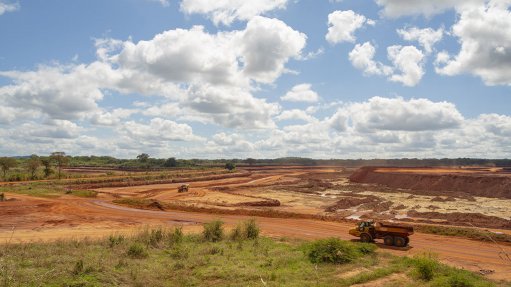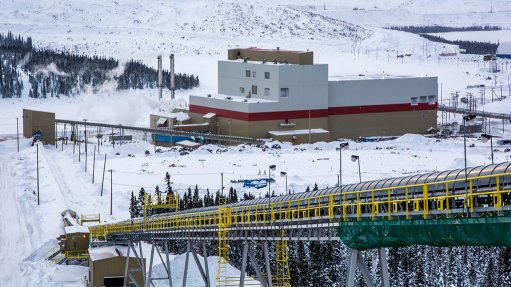Water management key to fuel cell optimisation, says Necsa
Management of water in polymer electrolyte membrane (PEM) fuel cells is one of the main goals in the optimisation of hydrogen fuel cell technology.
According to a case study by International Atomic Energy Agency, the one critical factor for the performance and durability of PEM fuel cells is to avoid the flooding of the electrodes with the water generated as a by-product.
Transport of fuel, reactant and by-product are not well understood, emphasising the need for ongoing research to optimise PEM fuel cells physical morphology and operating conditions.
The only way to visualise the internal transport of liquid water, the by-product, within an operating fuel cell or electrolyser, is through the application of neutron radiography/tomography (NRAD), a nondestructive analytical technique, Dr Frikkie de Beer, chief scientist and local expert on the NRAD technique at the State-owned South African Nuclear Energy Corporation (Necsa), says in a release prepared for this Mining Weekly feature on fuel cells.
Neutrons happen to have high penetrability through fuel cell structural materials such as titanium, copper or iron, but are sensitively attenuated by hydrogen containing compounds, such as water. This makes the NRAD technique particularly suited for in situ PEM fuel cells optimisation studies. These properties of neutron interaction with matter enable scientists and engineers to detect and observe the water flow within an operational PEM fuel cell, as well as the production of hydrogen through the electrolysis process in the reverse operation of this fuel cell.
It is possible, using sensitive modern neutron detection methods, to quantify water and hydrogen content as a function of position inside this variety of fuel cell to less than ten micron per pixel element in the resulting radiograph. Optimisation and characterisation of flow fields, quantification of liquid water content in the anode and cathode during in situ operation of these fuel cells or electrolysers, as well as performance of membranes within the cells, are only a few important parameters that have been optimised using NRAD.
International Collaboration
Internationally, NRAD has been applied for nearly two decades to visualise the water distribution in PEM fuel cells and addresses various issues related to water management. The application ranges from small-scale cells of a few square centimetres to full-size technical cells.
Current designs of PEM fuel cells incorporate the information first derived with neutron radiography, including the transport of water in the cathode side, its diffusion to the fuel injection channels and the wetting of the membrane on the anode side.
Ongoing research to understand these processes, using neutrons, is currently being conducted by scientists and manufacturers of PEM fuel cells at international NRAD facilities, including those in the US at Pennsylvania State University and the National Institute of Standards and Technology (NIST), in Europe, at the Helmholtz Centre Berlin and Paul Scherer Institute, Villigen PSI, Switzerland, and, in Asia, at the Kyoto University Research Reactor Institute, the Japan Atomic Energy Research Institute and the Korean Atomic Energy Research Institute, South Korea. These NRAD facilities have played an essential role in optimising the functioning of PEM fuel cells.
International researchers also use neutron radiography imaging to investigate the structural stability and spatial as well as temporal variations of hydrogen concentration – qualitative as well as quantitative analysis of hydrogen absorption and desorption kinetics – in metal hydride composites that store hydrogen chemically and release it upon exposition to higher temperatures.
The possibility for South African researchers to access neutron beam lines abroad is strengthened by an engagement between the European Spallation Source (ESS) and South Africa through the European Commission’s Group of Senior Officials on Global Research Infrastructures to guide its expansion beyond Europe.
The engagement continued and gained momentum in July last year when Necsa’s respective neutron diffraction and neutron radiography/tomography beam line experts, Dr Andrew Venter and Dr De Beer, visited Lund, Sweden, as members of the South African delegation chaired by Department of Science and Innovation (DSI) Basic Sciences and Infrastructure chief director Dr Daniel Adams.
Since January, Necsa and iThemba LABS participate as the South African consortium in the BrightnESS² partnership – a European Union-funded project within the European Commission’s Horizon 2020 Research and Innovation programme.
The South African consortium seeks to expand the neutron landscape available to researchers by following a two-pronged approach, by assessing the activities where South African researchers are actively involved in using neutron-based techniques in their research and by familiarising potential new users to the existing and future research prospects that neutron sciences can offer.
The traditional thermal neutron beam line techniques existing at Necsa can be vastly complemented and expanded with the availability of the ESS suite of facilities in scattering based applications with the added enhanced sensitivities of cold neutron beams in the study of pertinent topics in material science, energy, health, biology, cultural heritage and agriculture.
Part of the activities to achieve these goals are the hosting of two capacitating workshops in South Africa. The first took place last month at iThemba LABS and focused on capacity building in neutron research in the country. About 58 scientists were invited from academia and industry to be introduced to the value-adding capabilities of neutrons in research.
The goals achieved included familiarisation of potential new users with the benefits that existing neutron science expertise can offer; a compilation of a database of researchers and institutions involved in neutron research in South Africa; and available expertise including current researchers actively involved existing facilities and infrastructure. In addition, the workshops endeavour to establish agreement on the areas of neutron research of relevance to South Africa and agreement on the feasible high-impact research areas that will form the basis to enter into partnership with ESS.
The second South African Workshop on Capacity Building: Neutron Research, is a follow-up workshop scheduled for June 2020 at Necsa. Inputs from the South African research community will be used for the formulation of a South African position paper and the setup of governance structures.
South Africa’s Capability
Activities at nuclear reactors, such as the Koeberg nuclear power station, near Melkbosstrand on the west coast of South Africa, and the SAFARI-1 research reactor at Pelindaba, in the Hartbeespoort Dam region of the North West province, are generally perceived to be only electricity and medical isotopes production related respectively. However, the role of neutron beam lines at the SAFARI-1, and their value as research probes, is very much unknown, unreported, and underestimated within the research, industrial and public domains.
Necsa’s SAFARI-1 nuclear research reactor is equipped with open channels from the reactor core where beams of free neutrons, as products from the fission process, travel in a confined manner through samples, placed in its path, on to a range of detector types where scientific information about the sample can be extracted.
Since reporting on a new NDT facility that serves local and international users in Engineering News of October 17, 2003, and about the capabilities of the neutron tomography and diffraction beam lines at the SAFARI-1 research reactor of Necsa in Engineering News of October 14, 2005, the radiation beam line facility user group grew.
The micro-focus X-ray tomography facility, as reported in Engineering News of August 19, 2011, and an X-ray diffraction facility at Necsa, serve as a complementary X-ray capability to the existing neutron science expertise at Necsa.
Some practical experience in the field of NRAD and PEM’s by South African researchers has been gained, in the field of electrolysis, as a result of a cooperation between Necsa and Hydrogen South Africa (HySA), in collaboration with Dr Dmitri Bessarabov and postgraduate students, including Jan-Hendrik van der Merwe in 2015, and Carel Minnaar in 2018, from HySA Infrastructure, North-West University.
The research has been focusing on the imaging and quantification of water to investigate and understand more about the mechanism of water transport during the in-situ operation of an electrolyser. As Necsa facilities are currently being upgraded, this work was performed by Dr De Beer at the NRAD facility at NIST, in the US.
While the upgrade of the NRAD facility at SAFARI-1 towards international standards is under way and scheduled to be completed in 2021, Necsa has an obligation to continue to assist local researchers within the hydrogen energy sector by applying for beam time and improving their skills at international NRAD facilities.
Nuclear radiation has proven to be a most useful tool in the functional and operational optimisation of future renewable-energy sources such as PEM fuel cells and lithium-ion batteries. Specifically, the non-destructive analytical capabilities available at Necsa’s neutron beam lines can play a major role in support of the current and future South African initiative to localise analytical research capability to build capacity in support of the hydrogen economy, which also benefits the use of the platinum-group metals strategic resources of South Africa.
Comments
Press Office
Announcements
What's On
Subscribe to improve your user experience...
Option 1 (equivalent of R125 a month):
Receive a weekly copy of Creamer Media's Engineering News & Mining Weekly magazine
(print copy for those in South Africa and e-magazine for those outside of South Africa)
Receive daily email newsletters
Access to full search results
Access archive of magazine back copies
Access to Projects in Progress
Access to ONE Research Report of your choice in PDF format
Option 2 (equivalent of R375 a month):
All benefits from Option 1
PLUS
Access to Creamer Media's Research Channel Africa for ALL Research Reports, in PDF format, on various industrial and mining sectors
including Electricity; Water; Energy Transition; Hydrogen; Roads, Rail and Ports; Coal; Gold; Platinum; Battery Metals; etc.
Already a subscriber?
Forgotten your password?
Receive weekly copy of Creamer Media's Engineering News & Mining Weekly magazine (print copy for those in South Africa and e-magazine for those outside of South Africa)
➕
Recieve daily email newsletters
➕
Access to full search results
➕
Access archive of magazine back copies
➕
Access to Projects in Progress
➕
Access to ONE Research Report of your choice in PDF format
RESEARCH CHANNEL AFRICA
R4500 (equivalent of R375 a month)
SUBSCRIBEAll benefits from Option 1
➕
Access to Creamer Media's Research Channel Africa for ALL Research Reports on various industrial and mining sectors, in PDF format, including on:
Electricity
➕
Water
➕
Energy Transition
➕
Hydrogen
➕
Roads, Rail and Ports
➕
Coal
➕
Gold
➕
Platinum
➕
Battery Metals
➕
etc.
Receive all benefits from Option 1 or Option 2 delivered to numerous people at your company
➕
Multiple User names and Passwords for simultaneous log-ins
➕
Intranet integration access to all in your organisation


















